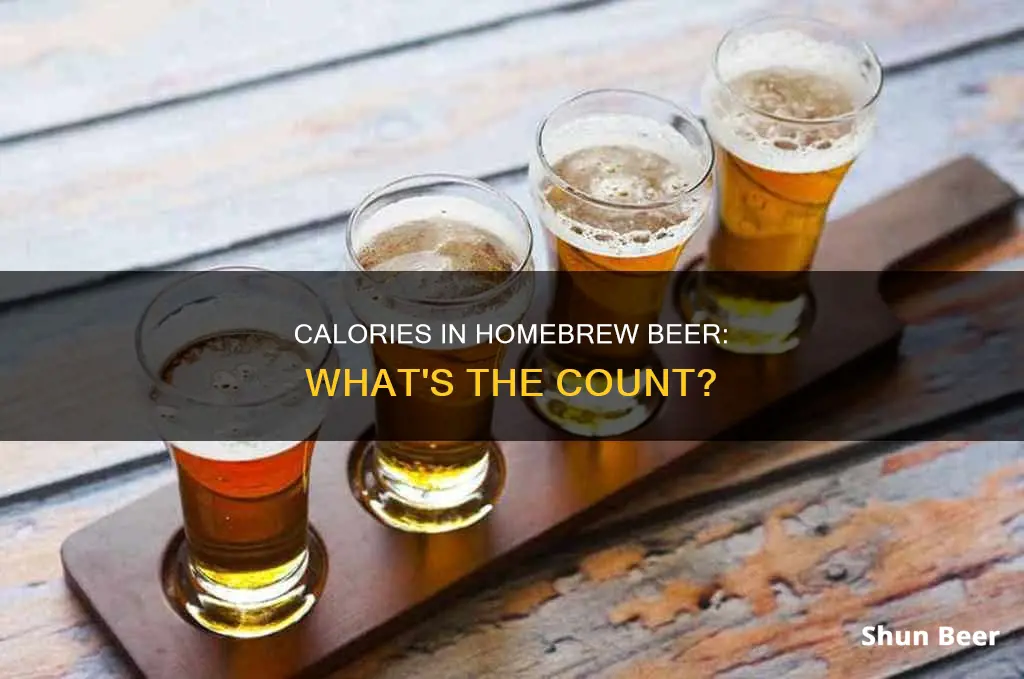
If you're a homebrewer, you might be wondering how many calories are in your beer. The answer depends on the original and final gravities of the beer in question. The higher the alcohol content, the more calories your beer will contain. You can calculate the calories from alcohol and carbohydrates separately, then add them together to get the total calories. So, if you're curious about the calorie content of your homebrew, grab a calculator and get ready to do some math!
What You'll Learn

Calories in beer come from alcohol and carbohydrates
Beer is made from grains, which can be healthy, but it is not considered a health drink. Beer can be part of a healthy diet as long as it is consumed in moderation, which is defined as no more than two drinks per day or 14 drinks per week for men and no more than one drink per day or seven drinks per week for women.
The calories in beer come primarily from alcohol and carbohydrates. The amount of calories and carbohydrates in beer depends on the type of beer and the brewing process. Dark beers, for example, tend to have more carbohydrates than light beers due to the addition of malts during the brewing process.
During fermentation, yeast breaks down simple carbohydrates, but longer chains of carbohydrates that the yeast cannot break down remain in the finished beer and contribute to the overall calorie count. In general, about 60% of the calories in beer come from alcohol, while the remaining 40% come from residual carbohydrates.
The higher the alcohol content in a beer, the more calories it will have. For example, a 12-ounce lager with 4.5% ABV has approximately 135 calories, while a 12-ounce barrel-aged stout with 10.5% ABV has about 315 calories.
Beer also contains minimal protein, with light beers containing around 0.7 grams and regular or dark beers containing about 1.6 grams per serving.
While beer does contain some vitamins and minerals, such as folate, niacin, magnesium, and potassium, these are more abundantly found in whole foods. Additionally, the calories from alcohol do not provide the same nutritional value as calories from other sources.
It is important to note that beer makers often do not provide nutritional information on their packaging, so it can be challenging to determine the exact calorie content of a particular beer. However, there are online resources, such as the beer maker's website or nutrition data sites, that can provide this information.
Rainier Beer Calorie Count: Nutritional Facts
You may want to see also

Higher ABV means more calories
The higher the alcohol content in beer, the more calories it contains. This is because alcohol has a high calorific value, with about seven calories per gram, almost as much as fat, which contains nine calories per gram.
The amount of alcohol in a beer is measured by its ABV (alcohol by volume), which is the metric listed on the side of cans or bottles. This is a good indicator of how calorific a beer is in relation to other beers.
A beer's calories come from two main sources: alcohol and carbohydrates. The carbohydrates in beer come from malted grains used in the brewing process, which provide sugars that are then mostly broken down by yeast to form alcohol and CO2. However, not all carbohydrates are broken down, and the longer chains of carbohydrates that remain in the finished beer also contribute to its calorific content. In general, around 60% of the calories in beer come from alcohol, and the remaining 40% come from residual carbohydrates.
For example, a 12-ounce lager with 4.5% ABV will have around 135 calories, while a 12-ounce barrel-aged stout with 10.5% ABV will have around 315 calories. So, if you're watching your calorie intake, it's better to opt for a beer with a lower ABV.
It's worth noting that the colour of a beer is not a reliable indicator of its calorie content, as darker beers do not necessarily have more calories. Low-calorie beers tend to be lighter in colour because they use less grain in the brewing process, resulting in lower carbohydrate content and, therefore, fewer calories.
Calorie Counting: Red Stripe Beer's Nutritional Breakdown
You may want to see also

Calories = ABV% x 2.5 x ounces of beer
If you're a beer lover, you've probably wondered about the calorie content of your favourite beverage. Well, the calories in beer come from a mix of alcohol and carbohydrates, with grains being major contributors. The higher the alcohol content, or Alcohol by Volume (ABV), the higher the calorie intake. In fact, around 60% of beer calories are derived from alcohol, while carbohydrates make up about 40% of the calories in beer.
So, how do you calculate the calories in your beer? A simple formula to use is:
> Calories = ABV% x 2.5 x ounces of beer
For example, if you have a 16-ounce beer with an ABV of 6%, it would contain approximately 240 calories. This formula is a quick and easy way to estimate the calorie content of your beer, especially when you don't have detailed information about the beer readily available.
It's important to note that the calorie content of beer can vary depending on the brewing process, ingredients, and beer type. Darker malts and a higher malt content, for instance, tend to increase the calorie counts. Additionally, the longer the fermentation time, the higher the alcohol content and, consequently, the calorie content. So, if you're watching your calorie intake, opting for light beers or moderating your consumption can be a good idea.
Remember, while indulging in a beer can be enjoyable, understanding its impact on your health and weight is crucial. Excessive consumption of beer can lead to weight gain and even affect your organs. So, make sure to consume beer in moderation and consider your overall caloric intake to maintain a healthy lifestyle.
Mid-Strength Beer Calories: How Much Energy?
You may want to see also

Darker beers don't necessarily have more calories
It's a common misconception that darker beers are heavier and higher in calories. However, this isn't always the case. The colour of a beer is directly related to its malt content, and darker beers are made from grains that have been heavily roasted. While darker roasts add chocolate and coffee flavours, they don't necessarily add more alcohol or calories.
The calories in beer come from carbohydrates and alcohol content. The higher the alcohol content, the higher the calories. This is because it takes more sugar (in the form of maltose) to make more alcohol, resulting in more calories. So, if you're looking for a lower-calorie beer, it's better to choose a beer with a lower alcohol content, regardless of its colour.
For example, a light-bodied Samuel Adams Black Lager with 4.9% ABV has fewer than 200 calories in a 12-ounce serving. In comparison, a Bud Light, a common light beer, has 110 calories, and a Sierra Nevada Pale Ale has 175 calories. So, despite being darker in colour, the Samuel Adams Black Lager has fewer calories than these lighter beers.
The "lightest of the darkest" styles of beer include black lagers (or schwarzbiers), porters, and dry stouts. These beers typically have an alcohol content of around 4-5% ABV, which is similar to many light beers. So, if you're looking for a low-calorie option, don't automatically dismiss the darker beers on the menu. Instead, pay attention to the alcohol content to make a more informed choice.
Calorie Counting: Beer Shots and Their Caloric Value
You may want to see also

Calories from alcohol = 1881.22 x FG x (OG-FG) / (1.775 - OG)
The formula "Calories from alcohol = 1881.22 x FG x (OG-FG) / (1.775 - OG)" is used to calculate the number of calories in a beer, where FG is the final gravity and OG is the original gravity. The formula is specifically designed for beers and similar beverages, and it estimates the calories contributed by the alcohol and the residual carbohydrates left behind after fermentation.
The formula is part of a broader method for calculating the total calories in a beer, which also includes the calories from carbohydrates. The total calories are calculated as follows:
Calories from alcohol + Calories from carbohydrates = Total calories
The formula for calculating the calories from carbohydrates is as follows:
Calories from Carbohydrates = 3550 x FG x ((0.1808 x OG) + (0.8192 x FG) – 1.0004)
These formulas are based on the specific gravity or alcohol by volume (ABV) of the beer. The specific gravity refers to the relative density of the liquid compared to water, and it is used to assess the potential alcohol content of the beer. The ABV represents the amount of alcohol content in a 3.4 oz drink and is represented as a percentage.
It's important to note that these formulas provide approximations, and the actual calorie content of a beer may vary depending on the ingredients and brewing process. Additionally, the color of a beer is not a reliable indicator of its calorie content. Darker beers do not necessarily have higher calories, as the color depends on the amount of grain used in the brewing process.
By using these formulas, you can gain a better understanding of the calorie content of your homebrew beer and make informed decisions about your consumption.
Calories in Radler Grapefruit Beer: A Healthy Option?
You may want to see also
Frequently asked questions
The number of calories in your homebrew beer depends on the type of beer, the ingredients used, and the brewing process. You can calculate the calories in your beer by using the following formula: Calories = ABV% x 2.5 x ounces of beer. Alternatively, you can use an online beer calorie calculator.
The calorie content of beer is influenced by the alcohol content and the amount of carbohydrates. Higher alcohol content and higher carbohydrate levels will result in a higher calorie count. The brewing process can also impact the calorie content, with craft beers typically having higher calories due to higher ABV, less optimized sugar utilization, and the addition of raw ingredients.
Contrary to popular belief, the colour of beer is not a reliable indicator of its calorie content. Darker beers do not necessarily have higher calories. Low-calorie beers that are light in colour achieve this by minimizing the use of grains and using adjuncts instead, resulting in fewer residual carbohydrates while maintaining the alcohol level.
To reduce the calorie content of your homebrew beer, you can aim for lower alcohol content, minimize the use of grains, and use adjuncts such as corn or rice to reduce residual carbohydrates. Additionally, choosing lighter beers, moderating consumption, and making healthier food choices can help manage your overall calorie intake.







